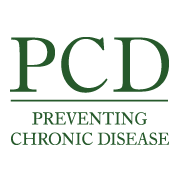PCD News Summary for December 29, 2016

About the Journal
Published every Thursday, Preventing Chronic Disease (PCD) is a peer-reviewed online journal established by CDC’s National Center for Chronic Disease Prevention and Health Promotion. The News Media Branch prepares press summary packets each week. To receive these press summaries on an embargoed basis, send an e-mail to media@cdc.gov. Please note that this e-mail list is for credentialed journalists only. All others, please visit Hookup to Health to sign up for e-mail updates
Notice to News Media - PCD Release Time and Embargo Policy:
CDC’s News Media Branch releases to reporters the PCD media packet every Tuesday afternoon between 12 and 2 pm.
Association Between Sitting Time and Cardiometabolic Risk Factors After Adjustment for Cardiorespiratory Fitness, Cooper Center Longitudinal Study, 2010–2013
Melissa Newton
mnewton@cdc.gov
404-718-6281
Men who sat more were more likely to be obese regardless of age, smoking status, or alcohol intake. Investigators examined men’s obesity levels by the size of their waistlines and by percent body fat. No matter which measure of obesity was used, the more men sat, the more likely they were to be obese.
Using Health Information Technology and Data to Improve Chronic Disease Outcomes in Federally Qualified Health Centers in Maryland
Melissa Newton
mnewton@cdc.gov
404-718-6281
The Mid-Atlantic Association of Community Health Centers not only developed a data aggregation platform to support health centers in using population health data, but also put the infrastructure in place to make the most of the new data-analysis capabilities. A data warehouse capable of aggregating electronic health record data across multiple health centers provides opportunities for benchmarking and serves as an impetus for conversations around quality improvement, including identifying and sharing clinical best practices. The effective use of electronic health record data has the potential to improve chronic disease outcomes among patients, including the vulnerable populations served by Federally Qualified Health Centers.
Geographic Variations in Incremental Costs of Heart Disease Among Medicare Beneficiaries, by Type of Service, 2012
Melissa Newton
mnewton@cdc.gov
404-718-6281
Inpatient, post-acute care, and outpatient services contributed most to incremental costs of heart disease among fee-for-service Medicare beneficiaries. Beneficiaries with heart disease had, on average, over $10,000 more in healthcare costs compared with those without heart disease; the largest differences were primarily in southern and Appalachian counties. Some of the regional differences in cost might be associated with the types of care beneficiaries received. Public health and health care systems can use these findings to inform development of policies and payment models that address geographic differences in the costs of care and type of care used among Medicare beneficiaries with heart disease.
Community Health Workers as Allies in Hypertension Self-Management and Medication Adherence in the United States, 2014
Melissa Newton
mnewton@cdc.gov
404-718-6281
Researchers identified the unique roles community health workers (CHWs) play in hypertension self-management and medication. CHWs can address barriers to hypertension control among underrepresented and diverse populations. Roles were described as flexible and multifaceted but patient-driven. CHWs interacted with patients through individual clinic sessions or home visits. On average, they spend seven months working with patients for about 40 minutes per visit. CHWs often address barriers around medicine taking and refills and support patient-provider communication.
An Evaluability Assessment of the West Virginia Physical Activity Plan, 2015: Lessons Learned for Other State Physical Activity Plans
Melissa Newton
mnewton@cdc.gov
404-718-6281
While multi-sector collaboration is important for increasing population-level physical activity, a recent assessment of West Virginia’s physical-activity plan highlights the need to simplify the plan to make it a more locally driven process that engages communities. The National Physical Activity Plan serves as a model for bringing many sectors together to create a vision for increasing population-level physical activity. Statewide physical activity plans have been created in just a few states but evaluating their impact has proven difficult. Researchers conducted an evaluability assessment of the West Virginia Physical Activity Plan to assess stakeholder needs and gather input about implementation and evaluation of the plan.
###
U.S. DEPARTMENT OF HEALTH AND HUMAN SERVICES
CDC works 24/7 protecting America’s health, safety and security. Whether diseases start at home or abroad, are curable or preventable, chronic or acute, stem from human error or deliberate attack, CDC is committed to respond to America’s most pressing health challenges.
- Page last reviewed: December 29, 2016
- Page last updated: December 29, 2016
- Content source:
Error processing SSI file


 ShareCompartir
ShareCompartir